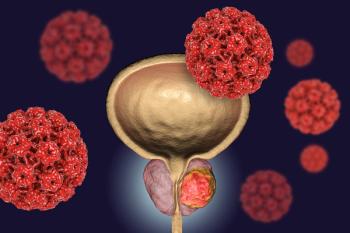
Intense-modulated therapy was associated with less patient-reported toxicities than conventional radiotherapy and demonstrated a comparable efficacy profile.

Intense-modulated therapy was associated with less patient-reported toxicities than conventional radiotherapy and demonstrated a comparable efficacy profile.

Avasopasem was associated with a significant reduction in severe oral mucositis in patients with locally nonmetastatic head and neck cancer undergoing chemoradiotherapy.

Kate Sandstrom, MSN, APRN-BC, AOCN, discusses the importance of including the radiation oncology team in a patient’s long-term care plan.

Single nucleotide polymorphism (SNP) genotyping could be used to predict radiation dermatitis in patients with breast cancer.

A newly designed model will outline what genetic patterns put men with prostate cancer at an increased risk of toxic side effects.

An expert from the Institut Curie discusses the risk-benefit ratio associated with NBTXR3 plus radiotherapy for the treatment of patients with soft tissue sarcoma.

Inguinofemoral radiotherapy may be a safe alternative for patients with vulvar cancer and sentinel node micrometastases who might otherwise face the morbidity of a lymphadenectomy.

Patient Reported Outcomes Measurement Information System scoring suggested that wound complication was associated with more severe anxiety and decreased physical function in patients receiving radiation therapy for soft tissue sarcoma.

Patients with prostate cancer fared better following treatment with magnetic resonance-guided focused ultrasound focal therapy than with radical prostatectomy or radiation therapy, shows study presented at 2021 AUA Annual Meeting.

Treating patients with brentuximab vedotin in combination with doxorubicin, vinblastine, and dacarbazine with and without consolidative radiotherapy resulted in strong efficacy and encouraging tolerability in early-stage, unfavorable-risk Hodgkin lymphoma.

Adjuvant radiation therapy treatment yielded strong results in reducing all-cause mortality in patients with high-risk prostate cancer.

Out of 30 patients, 16 demonstrated significant pathological responses and 8 achieved a complete pathological response.

A number of treatment options exist for patients with localized hepatocellular carcinoma, including surgical resection, transplantation, ablation, stereotactic body radiotherapy,, and embolization.

A reduction in patient-reported symptomatic adverse events (AEs) was observed with intensity-modulated radiotherapy (IMRT) compared with standard radiotherapy in patients with cervical or endometrial cancer, whereas no difference was observed with regard to clinician-reported AE.

Partial-breast radiation may be more convenient for patients with breast cancer, and according to recent research, the outcomes aren’t much different than patients who had whole-breast radiation.

Partial-breast radiation may be more convenient for patients with breast cancer, and according to recent research, the outcomes aren’t much different than patients who had whole-breast radiation.

Radiation dermatitis is a common adverse event for patients with head and neck cancer undergoing radiation therapy, but a new kind of dressing may help.

Children with pediatric posterior fossa tumors like medulloblastoma who are treated with radiotherapy may be less likely to recall specific details of events that occurred after treatmen.

The FDA approved sargramostim (Leukine) for the treatment of adult and pediatric with hematopoietic subsyndrome of acute radiation syndrome (H-ARS).

Radiotherapy treatments for Hodgkin lymphoma may raise the risk of certain breast cancer subtypes, a study of data on women survivors from the Surveillance, Epidemiology, and End Results (SEER) registries revealed.

The FDA has approved a novel breast-specific stereotactic body radiotherapy (SBRT) device known as GammaPod as a treatment for patients with early breast cancer, based on findings from a 17-patient study.

By developing a training program, nurses in radiation at Johns Hopkins Hospital were able to eliminate the use of anasthesia for pediatric patients.

Stereotactic body radiation therapy (SBRT) is highly effective, and potentially curable for early-stage lung cancer, though not many physicians use the therapy, says expert Molly Freeman, CNP.

For patients with recurrent prostate cancer, adding hormonal therapy to post-surgical radiation treatment significantly improves survival, according to a recent study.

For patients with HPV-related oropharyngeal squamous cell carcinoma, induction chemotherapy plus reduced-dose radiation and weekly cetuximab brought improvements for swallowing and nutritional status along with complete clinical responses.

Molly Freeman explains why it is necessary for providers to be educated on stereotactic body radiation therapy.

Molly Freeman, CNP, discusses the aftercare that goes into treating patients with lung cancer who have undergone stereotactic body radiation therapy (SBRT).

Dr. Puneeth Iyengar discusses the use of a hypofractioned course of radiation therapy for patients with stage 3 NSCLC instead of a combination of chemotherapy and radiation.

Deborah Watkins Bruner, RN, PhD, FAAN, discusses the results of a trial comparing quality of life after conventional radiotherapy and after a hypofractionated schedule for men at low-risk for prostate cancer.

Pelvic IMRT causes less GI, GU toxicities than standard pelvic radiation therapy for patients with gynecologic cancers.